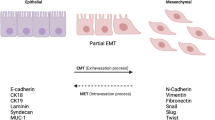Abstract
Background
The high mobility group protein A2 (HMGA2) is an architectural transcription factor that plays an important role in the development and progression of many malignant neoplasms. High expression of HMGA2 in gastric cancer correlates with invasiveness of cancer and is an independent prognostic factor. The reason for this might be HMGA2 promoting epithelial–mesenchymal transitions (EMT), which is the key process of metastasis for some underlying mechanisms.
Aims
This study was designed to test whether HMGA2 participates in the EMT and to further understand the underlying mechanisms of EMT promoted by HMGA2.
Methods
We examined the cell biology and molecular biology changes after overexpression and knockdown HMGA2 of gastric cancer cells in vitro and vivo. To further understand the underlying mechanisms of EMT promoted by HMGA2, based on our previous study, we examined the changes of target genes of HMGA2 after overexpression and knockdown HMGA2 of gastric cancer cells.
Results
The results indicated that overexpressing HMGA2 enabled enhancing the oncogenic properties of gastric epithelial origin cell in vitro and in vivo. Furthermore, our study showed that HMGA2 was able to elicit EMT and regulate several genes which are closely related to the Wnt/β-catenin pathway by directly binding to their promoter thereby activating the Wnt/β-catenin pathway.
Conclusions
The Wnt/β-catenin pathway activated by HMGA2 might be the underlying mechanism of EMT in gastric cancer cells.






Similar content being viewed by others
References
Parkin DM, Bray F, Ferlay J, et al. Global cancer statistics, 2002. CA Cancer J Clin. 2005;55:74–108.
Wu Y, Zhou BP. New insights of epithelial–mesenchymal transition in cancer metastasis. Acta Biochim Biophys Sin (Shanghai). 2008;40:643–650.
Fuxe J, Vincent T, Garcia de Herreros A. Transcriptional crosstalk between TGF-beta and stem cell pathways in tumor cell invasion: role of EMT promoting Smad complexes. Cell Cycle. 2010;9:2363–2374.
Bates RC, Mercurio AM. The epithelial–mesenchymal transition (EMT) and colorectal cancer progression. Cancer Biol Ther. 2005;4:365–370.
Thiery JP, Acloque H, Huang RY, et al. Epithelial–mesenchymal transitions in development and disease. Cell. 2009;139:871–890.
Eramo A, Haas TL, De Maria R. Lung cancer stem cells: tools and targets to fight lung cancer. Oncogene. 2010;29:4625–4635.
Kratz JR, Yagui-Beltran A, Jablons DM. Cancer stem cells in lung tumorigenesis. Ann Thorac Surg. 2010;89:S2090–S2095.
Dirks PB. Cancer: stem cells and brain tumours. Nature. 2006;444:687–688.
Biddle A, Liang X, Gammon L, et al. Cancer stem cells in squamous cell carcinoma switch between two distinct phenotypes that are preferentially migratory or proliferative. Cancer Res. 2011;71:5317–5326.
Chen C, Wei Y, Hummel M, et al. Evidence for epithelial–mesenchymal transition in cancer stem cells of head and neck squamous cell carcinoma. PLoS One. 2011;6:e16466.
Mani SA, Guo W, Liao MJ, et al. The epithelial–mesenchymal transition generates cells with properties of stem cells. Cell. 2008;133:704–715.
Hock R, Furusawa T, Ueda T, et al. HMG chromosomal proteins in development and disease. Trends Cell Biol. 2007;17:72–79.
Meyer B, Loeschke S, Schultze A, et al. HMGA2 overexpression in non-small cell lung cancer. Mol Carcinog. 2007;46:503–511.
Langelotz C, Schmid P, Jakob C, et al. Expression of high-mobility-group-protein HMGI-C mRNA in the peripheral blood is an independent poor prognostic indicator for survival in metastatic breast cancer. Br J Cancer. 2003;88:1406–1410.
Belge G, Meyer A, Klemke M, et al. Upregulation of HMGA2 in thyroid carcinomas: a novel molecular marker to distinguish between benign and malignant follicular neoplasias. Genes Chromosom Cancer. 2008;47:56–63.
Motoyama K, Inoue H, Nakamura Y, et al. Clinical significance of high mobility group A2 in human gastric cancer and its relationship to let-7 microRNA family. Clin Cancer Res. 2008;14:2334–2340.
Miyazawa J, Mitoro A, Kawashiri S, et al. Expression of mesenchyme-specific gene HMGA2 in squamous cell carcinomas of the oral cavity. Cancer Res. 2004;64:2024–2029.
Thuault S, Valcourt U, Petersen M, et al. Transforming growth factor-beta employs HMGA2 to elicit epithelial–mesenchymal transition. J Cell Biol. 2006;174:175–183.
Watanabe S, Ueda Y, Akaboshi S, et al. HMGA2 maintains oncogenic RAS-induced epithelial–mesenchymal transition in human pancreatic cancer cells. Am J Pathol. 2009;174:854–868.
Wu J, Liu Z, Shao C, et al. HMGA2 overexpression-induced ovarian surface epithelial transformation is mediated through regulation of EMT genes. Cancer Res. 2011;71:349–359.
Nishino J, Kim I, Chada K, et al. Hmga2 promotes neural stem cell self-renewal in young but not old mice by reducing p16Ink4a and p19Arf expression. Cell. 2008;135:227–239.
Yu F, Yao H, Zhu P, et al. let-7 Regulates self renewal and tumorigenicity of breast cancer cells. Cell. 2007;131:1109–1123.
Zha L, Wang Z, Tang W, et al. Genome-wide analysis of HMGA2 transcription factor binding sites by ChIP on chip in gastric carcinoma cells. Mol Cell Biochem. 2012;364:243–251.
Thiery JP. Epithelial–mesenchymal transitions in tumour progression. Nat Rev Cancer. 2002;2:442–454.
Khan NP, Pandith AA, Hussain MU, et al. Novelty of Axin 2 and lack of Axin 1 gene mutation in colorectal cancer: a study in Kashmiri population. Mol Cell Biochem. 2011;355:149–155.
Levayer R, Lecuit T. Breaking down EMT. Nat Cell Biol. 2008;10:757–759.
Schoenmakers EF, Wanschura S, Mols R, et al. Recurrent rearrangements in the high mobility group protein gene, HMGI-C, in benign mesenchymal tumours. Nat Genet. 1995;10:436–444.
Pozharskaya V, Torres-Gonzalez E, Rojas M, et al. Twist: a regulator of epithelial-mesenchymal transition in lung fibrosis. PLoS One. 2009;4:e7559.
Yu L, Li HZ, Lu SM, et al. Down-regulation of TWIST decreases migration and invasion of laryngeal carcinoma Hep-2 cells by regulating the E-cadherin, N-cadherin expression. J Cancer Res Clin Oncol. 2011;137:1487–1493.
Pfannkuche K, Summer H, Li O, et al. The high mobility group protein HMGA2: a co-regulator of chromatin structure and pluripotency in stem cells? Stem Cell Rev. 2009;5:224–230.
Acknowledgments
The project was supported by the National Natural Science Foundation of China (No. 81272753).
Conflict of interest
None.
Author information
Authors and Affiliations
Corresponding author
Rights and permissions
About this article
Cite this article
Zha, L., Zhang, J., Tang, W. et al. HMGA2 Elicits EMT by Activating the Wnt/β-catenin Pathway in Gastric Cancer. Dig Dis Sci 58, 724–733 (2013). https://doi.org/10.1007/s10620-012-2399-6
Received:
Accepted:
Published:
Issue Date:
DOI: https://doi.org/10.1007/s10620-012-2399-6




